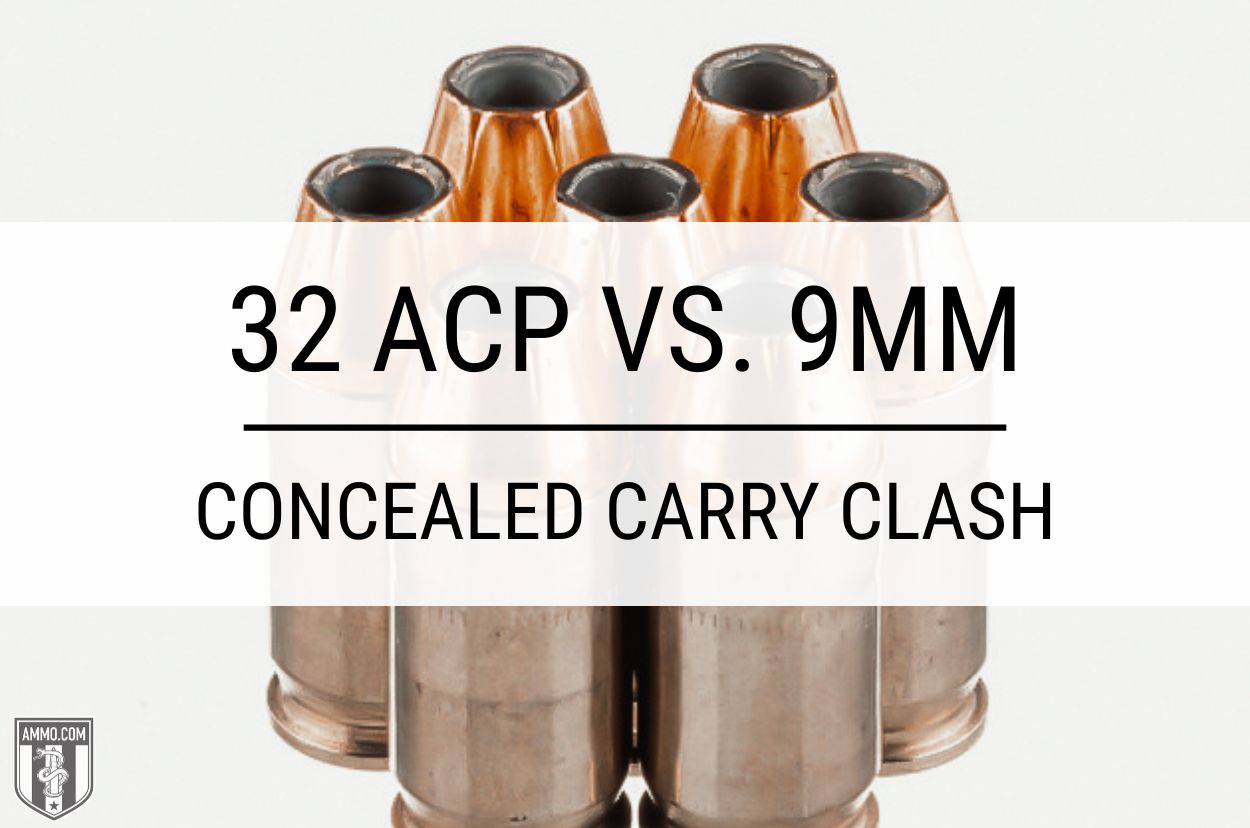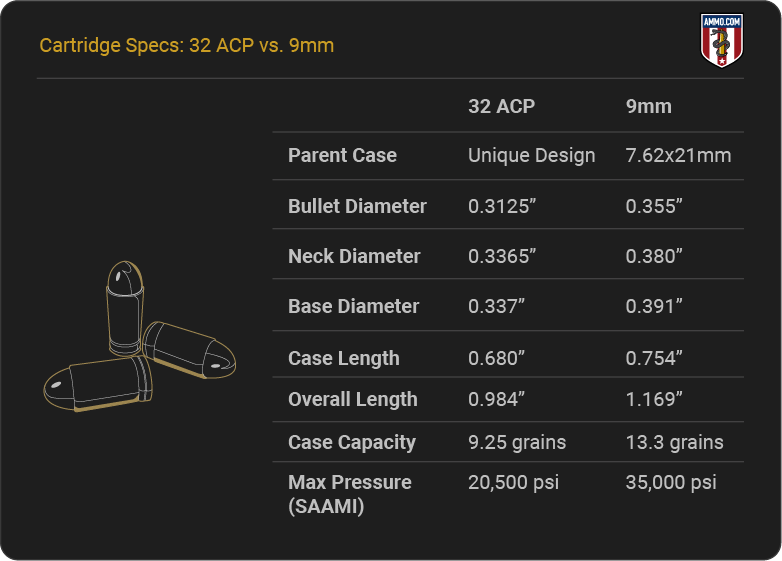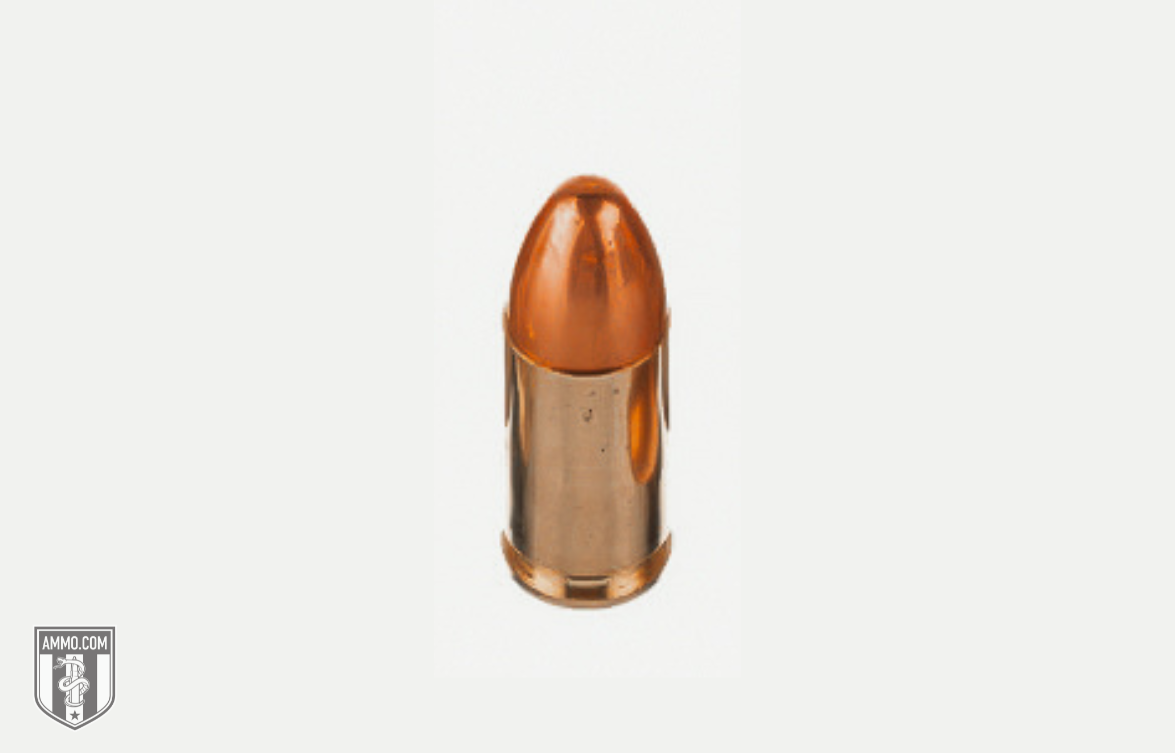32 ACP vs. 9mm: Concealed Carry Clash
 When looking for a new concealed carry cartridge, you’ve likely considered the 380 ACP, 9mm, and 45 ACP. However, John Moses Browning created a legendary cartridge– the 32 ACP –that might be worth considering.
When looking for a new concealed carry cartridge, you’ve likely considered the 380 ACP, 9mm, and 45 ACP. However, John Moses Browning created a legendary cartridge– the 32 ACP –that might be worth considering.
Throughout this article, we’ll compare the 32 ACP vs. 9mm in critical categories most important to shooters and concealed carriers. Recoil, accuracy, stopping power, and self-defense capabilities are a few sections we will discuss in detail to help us determine a winner.
Once you finish reading, you can confidently choose the best cartridge for your situation.
Let’s go!
32 ACP vs. 9mm
The 9mm is also called the 9x19mm Parabellum, 9x19mm NATO, 9mm NATO, or 9mm Luger. In Europe, the .32 ACP is called the 7.65mm Browning.
Both centerfire handgun cartridges are over 100 years old, so a less experienced shooter might think they’re obsolete. In fact, the 9mm remains a favorite of many concealed-carry enthusiasts and law enforcement officers. Meanwhile, the 32 ACP struggles to stay relevant.
The 9mm and 32 Auto are chambered in semi-automatic pistols. The 32 ACP was designed for pocket pistols, like the Beretta Tomcat and KelTec P32, whereas the 9mm was designed for full-size pistols. In recent decades, carbines and revolvers have been designed around the 9mm cartridge.
Below, you’ll discover the technical specs that make these cartridges unique. Afterward we’ll begin our comparison to help you decide which personal defense cartridge is right for you!
Technical Specs: 9mm vs. 32 ACP

The 32 ACP cartridge is noticeably smaller than the 9mm, as it fires a smaller diameter bullet, has less case capacity, and is shorter overall.
The bullet diameter of a 32 ACP round is 0.3125 inches, whereas the 9mm is 0.355 inches. The case capacity of the 9mm is 13.3 grains; the 32 ACP, only 9.25 grains. The 9mm’s higher case capacity and chamber pressure enable its heavier bullet to attain a higher muzzle energy – and strike with greater kinetic energy because of it.
While these cartridges have some significant differences, they were designed for similar tasks. Let’s see how these numbers translate into real-world situations.
Recoil
Recoil is a critical consideration when purchasing a new handgun, as a round with heavy recoil will be more challenging to control and slow your follow-up shots. The potential for recoil flinching (anticipation) is also an issue for cartridges with powerful kick.
Felt recoil will differ from shooter to shooter and is often dependent on firearm choice, stance, and your chosen ammo. However, free recoil is a more objective measure of how hard a cartridge hits based on firearm weight, muzzle velocity, powder charge, and bullet weight.
Both handgun rounds are known for having low recoil. We’ll compare two loads for reference.
For the 9mm, we’ll fire Winchester white box 115 grain full metal jacket (FMJ) with a muzzle velocity of 1,190 fps out of a Glock 45 weighing 2 pounds. Under these circumstances, the 9mm has a free recoil of 4 ft-lbs, which isn’t much.
For the 32 ACP, we’ll fire Fiocchi Range Dynamics 73 grain FMJ with a muzzle velocity of 1,000 fps out of a North American Arms Guardian weighing 0.8 pounds. Under these conditions, the 32 ACP has a free recoil of 1.7 ft-lbs – less than half that of the 9mm.
The 32 ACP wins this section because it has less recoil. Its very low recoil makes handling the firearm easier for most shooters.
Accuracy: 9x19mm Parabellum vs. .32 Auto
Cartridge accuracy depends on several factors, such as bullet design, firearm, shooter, and shooting conditions. That means this comparison can never be truly apples to apples.
However, we can still help you decide which one you might be more accurate with: a 9mm or 32 ACP pistol!
A “mouse gun” chambered for 32 ACP is an excellent option for recoil-sensitive shooters. When I was a kid, my grandpa had a 25 ACP pistol we would use for target shooting and firing into ballistic gel for fun. It didn’t have much recoil, and I was reasonably accurate with it. The same can be said for the 32 ACP. Its low recoil will probably allow you to be more accurate.
The advantage of the 9mm is its longer barrel. In some instances, this isn’t much of an advantage (compact pistols often used for concealed carry), but it is in others (full-size pistols and carbines). A longer barrel will help you be more accurate when firing a gun because it gives the propellant longer to burn, increasing the velocity of the round an flattening its trajectory. I carry a 9mm Smith & Wesson Shield and have accurate shot placement at the range.
This section is a draw, as some shooters will enjoy the lower recoil benefits of the 32 ACP, while others will take advantage of the longer barrels of 9mm pistols. I recommend testing several high-quality factory loads to see what your firearm handles the best.
Stopping Power
9mm enthusiasts harp on the mystical concept of “stopping power” and state that the .32 ACP is underpowered.
They aren’t wrong on paper. According to the numbers, the 9mm is the superior cartridge – but how is “stopping power” defined?
Although no column exists in the ballistics tables for stopping power, the FBI has done its best to quantify it by developing a complicated scoring system to evaluate handgun ammunition and its terminal performance after having pierced multiple barriers, such as drywall and sheet metal.
Here’s the simplified version: A bullet penetrating no less than 12 inches and no more than 16 inches into ballistic gelatin (a synthetic substitute for soft tissues) is optimal for self-defense.
Modern 9mm JHP ammo penetrates 13-15 inches on average. That’s precisely where you want it to be for a good home or self-defense cartridge.
Modern 32 ACP FMJ ammo penetrates 12-14 inches on average. That’s good, but it’s also using a full metal jacket, not a jacketed hollow point, which is better suited for self-defense.
The critical factor we’re ignoring is shot placement. It doesn’t matter how well the bullet penetrates the target if it hits the threat in a non-vital area, such as the foot or hand.
If shot placement is equal between a 9mm Luger and a 32 ACP, I’d always pick the 9mm as it's a more powerful round. However, if you’re more accurate with a .32 Auto, do not hesitate to use that as your CCW round.
The 9mm wins this section as it fires a heavier bullet, has more energy behind it, and penetrates deeper.
Self-Defense: 32 Automatic Colt Pistol vs. 9mm Luger
Since the 32 ACP was specifically designed for self-defense, one might think it will have an advantage here – although the 9mm’s development for warfare hardly makes it a poor choice for self-defense, either.
The 32 ACP is primarily found in pocket pistols, which are very easy to conceal due to their small size. However, this drastically limits their magazine capacity and accuracy capabilities. As we will see in the next section, 32 ACP ammo and firearm availability is much lower than 9mm, and it doesn’t penetrate as well, further hurting the cause.
All sorts of pistols and carbines are chambered in 9mm, so you can find the perfect one to pair with your 9mm personal protection ammo.
Unless you’re just a sucker for nostalgia and also think the 38 Special is a superior self-defense cartridge, the 9mm is the way to go.
The 9mm Luger wins this section because it offers better penetration (with a JHP) and more firearm and ammo options (as we’ll see soon).
Ammo & Firearm Costs & Availability
Even though 9mm is the larger cartridge, the ammo is less expensive. Target and self-defense ammo are also more readily available from brands like Federal, Hornady, Remington, Underwood, and many other ammunition manufacturers.
The 32 ACP is not expensive to fire, however. Firearms are priced similarly to 9mm handguns, and the ammo is only slightly more costly.
The 9mm wins this section because it is less expensive and has more ammo and gun options.
Reloading: 32 ACP vs. 9mm
Since the cartridges are well established, plenty of information and reloading supplies are available for each. The 9mm will likely be easier to reload due to its increased popularity, but it’s not significant enough to win this section.
This section is a draw.
Ballistics: 32 Auto vs. 9mm
This part of the article is for all you number lovers! If you love digging into the ballistics of each cartridge, then you’ll love what’s below!
Note: This information comes from the manufacturer. The actual ballistics obtained with your firearm can vary considerably from the advertised ballistics. Also, ballistics can vary from lot to lot with the same brand and type load.
32 ACP Ballistics
| 32 ACP Bullet WEIGHT | Muzzle VELOCITY (fps) | Muzzle ENERGY (ft. lbs.) | Mid-Range TRAJECTORY (in.) | Barrel Length (in.) | |||||
|---|---|---|---|---|---|---|---|---|---|
| Muzzle | 50 yds. | 100 yds. | Muzzle | 50 yds. | 100 yds. | 50 yds. | 100 yds. | ||
| 60 Grain JHP | 910 |
n/a | n/a | 125 | n/a | n/a | n/a | n/a | n/a |
| 60 Grain | 970 | 895 | 835 | 125 | 105 | 95 | 1.3 | 5.4 | 4" |
| 60 Grain | 1000 |
917 | 849 | 133 | 112 | 96 | n/a | n/a | 4" |
| 71 Grain FMJ | 800 | n/a | n/a | 100 | n/a | n/a | n/a | n/a | n/a |
| 71 Grain FMJ | 850 | n/a | n/a | 114 | n/a | n/a | n/a | n/a | n/a |
| 71 Grain FMJ | 905 | n/a | n/a | 129 | n/a | n/a | n/a | n/a | n/a |
| 71 Grain | 905 | 855 | 810 | 130 | 115 | 95 | 1.4 | 5.8 | 4" |
9mm Ballistics
| 9mm Bullet WEIGHT | Muzzle VELOCITY (fps) | Muzzle ENERGY (ft. lbs.) | Mid-Range TRAJECTORY (in.) | Barrel Length (in.) | |||||
|---|---|---|---|---|---|---|---|---|---|
| Muzzle | 50 yds. | 100 yds. | Muzzle | 50 yds. | 100 yds. | 50 yds. | 100 yds. | ||
| 80 Grain | 1445 | n/a | n/a | n/a | 385 | n/a | n/a | n/a | n/a |
| 88 Grain | 1500 |
1190 | 1010 | 440 | 275 | 200 | 0.6 | 3.1 | 4" |
| 90 Grain | 1360 | 1112 | 978 | 370 | 247 | 191 | n/a | n/a | 4" |
| 92 Grain | 1325 | 1117 | 991 | 359 | 255 | 201 | -3.2 | n/a | 4" |
| 95 Grain | 1300 | 1140 | 1010 | 350 | 275 | 215 | 0.8 | 3.4 | 4" |
| 100 Grain | 1180 | 1080 | n/a | 305 | 255 | n/a | 0.9 | n/a | 4" |
| 105 Grain "Guard Dog" | 1230 | 1070 | 970 | 355 | 265 | 220 | n/a | n/a | 4" |
| 115 Grain | 1155 | 1045 | 970 | 340 | 280 | 240 | 0.9 | 3.9 | 4" |
| 123 Grain | 1110 | 1030 | 970 | 340 | 290 | 260 | 1 | 4 | 4" |
| 124 Grain | 1150 | 1040 | 965 | 364 | 298 | 256 | -4.5 | n/a | 4" |
| 125 Grain | 1110 | 1030 | 970 | 340 | 290 | 260 | 1 | 4 | 4" |
| 135 Grain | 1010 | 960 | 918 | 306 | 276 | 253 | n/a | n/a | 4" |
| 140 Grain | 935 | 890 | 850 | 270 | 245 | 225 | 1.3 | 5.5 | 4" |
| 147 Grain | 990 | 940 | 900 | 320 | 290 | 265 | 1.1 | 4.9 | 4" |
| 90 Grain +P | 1475 | n/a | n/a | 437 | n/a | n/a | n/a | n/a | 4" |
| 115 Grain +P | 1250 | 1113 | 1019 | 399 | 316 | 265 | 0.8 | 3.5 | 4" |
| 124 Grain +P | 1180 | 1089 | 1021 | 384 | 327 | 287 | 0.8 | 3.8 | 4" |
To continue digging into 9mm ballistics, check out our other article!
32 ACP Brief History
The 32 ACP's roots go back to the legend of John Moses Browning. In 1899, he designed this handgun cartridge for the Fabrique Nationale 1900 blowback pistol.
The Colt Model 1903 Pocket Pistol was released in the U.S. in 1903, increasing the popularity of 32 Automatic Colt Pistol. Unsurprisingly, other firearms manufacturers released their semi-auto pistols chambered in .32 ACP.
The .32 ACP was carried by law enforcement and militaries around the world. Today its popularity has waned, but is still enjoyed by many shooters.
9mm Brief History
The 9mm was designed by Austrian gunsmith Georg Luger in 1901. Luger created the 9x19mm from his previous design, the 7.65x21mm Parabellum.
The 9mm was adopted by the Imperial German Navy in 1904, and then the Imperial German Army in 1908.
After World War I, the 9mm Parabellum became one of the most popular pistol cartridges worldwide for military and law enforcement use. The popularity of the 9mm exploded in the U.S. during the 1980s and 1990s.
There is no denying that the 9mm has established itself as one of the top self-defense cartridges, for many reasons.
Parting Shots
Now that you’ve read our 32 ACP vs. 9mm article, it’s time to tally the results.
The 32 ACP won one section (recoil). The 9mm won three sections (stopping power, self-defense, and availability). Two sections were a draw (accuracy and reloading).
The 9mm is the clear winner for most concealed carriers, as it offers more stopping power, ammo options, and firearm options without breaking the bank.
However, the 32 ACP is still fun to take to the range or use as a backup CCW.
No matter which you get, stock up on all your ammo needs at Ammo.com!
Ammo Comparisons
- .308 vs 5.56
- 6.5 Creedmoor vs .308
- .300 Blackout vs .308
- .300 Win Mag vs .308
- .243 vs .308
- .308 vs .30-06
- 7mm-08 vs .308
- .270 vs .308
- 7.62x39 vs .308
- .223 vs .308
- .338 Lapua vs .308
- .380 ACP vs 9mm
- .223 vs 5.56
- .300 Blackout vs 5.56
- 9mm vs 45 ACP
- 9mm vs 40 S&W
- .357 SIG vs 9mm
- 10mm vs 9mm
- 9mm vs 9mm Luger
- .243 vs .270
- .300 Win Mag vs .30-06
- .270 vs .30-06
- .40 vs .45
- 38 Special vs 357
- 9mm vs 40 vs 45
- 5.56 vs 7.62x39
- 338 Lapua vs .30-06
- .30-30 vs .30-06
- 300 PRC vs 338 Lapua
- .30-06 vs 7mm
- 300 Win Mag vs 338 Lapua
- 300 PRC vs 300 Win Mag
- 300 WSM vs 300 Win Mag
- 338 Win Mag vs 338 Lapua
- 12 Gauge vs 20 Gauge
- 10mm vs 357 Mag
- .30-30 vs 7.62x39
- 224 Valkyrie vs 22-250
- 17 HMR vs 22 Mag
- 7.62x39 vs .300 Blackout
- 45 ACP vs 45 Auto
- 45-70 vs 30-30
- 300 Blackout vs 223
- 357 Magnum vs 9mm
- 350 Legend vs 300 Blackout
- 224 Valkyrie vs 223
- 45 ACP vs 38 Super
- 6.5 Grendel vs .308
- 17 HMR vs 22 LR
- 10 Gauge vs 12 Gauge
- 22-250 vs 223
- 45 Colt vs 45 ACP
- 350 Legend vs 30-30
- 5.7x28 vs 223
- 5.7 vs 9mm
- 5.56 vs 5.7
- 22 vs 9mm
- Buckshot vs Birdshot
- 450 Bushmaster vs 308
- 450 Bushmaster vs 223
- Buckshot vs Slug
- 6.5 Grendel vs 5.56 vs 223
- 6mm ARC vs 6.5 Grendel
- 44 vs 45
- 458 SOCOM vs 5.56
- 357 vs 44
- 32 ACP vs 380
- 300 Win Mag vs 338 Win Mag vs 338 Lapua Mag
- 450 Bushmaster vs 458 SOCOM vs 50 Beowulf
- 6mm Creedmoor vs 6.5 Creedmoor
- TMJ vs FMJ
- 44 Special Vs 44 Magnum
- 45 90 vs 45 70
- 6.8 Western vs 6.8 SPC
- 50 Beowulf vs 50 BMG
- 26 Nosler vs 6.5 PRC
- 28 Gauge vs 410
- 6.8 SPC vs 5.56
- 6.8 SPC vs 6.5 Grendel
- 6.8 Western vs 7mm Rem Mag vs .28 Nosler
- 6.8 Western vs 6.5 Creedmoor
- 22 Hornet vs 223
- 6.8 Western vs 6.5 PRC
- .410 vs 12 Gauge
- .410 vs 20 Gauge
- 22 LR vs 22 Mag
- 6mm ARC vs 243
- 7mm-08 vs 270
- 243 vs 6.5 Creedmoor
- Nickel vs Brass Casing
- 204 Ruger vs 223
- 50 Beowulf vs 5.56
- 260 Remington vs 6.5 Creedmoor
- 6mm Remington vs 243
- 28 Nosler vs 300 PRC
- 50 Beowulf vs 50 AE
- 22 Nosler vs 22-250
- 450 Marlin vs 45-70
- 300 Win Mag vs 300 Norma
- 458 SOCOM vs 300 Blackout
- 38-55 vs 45-70
- 22 Hornet vs 22 LR
- 300 Norma vs 338 Lapua
- 338 Lapua vs 50 BMG
- 28 Nosler vs 300 Win Mag
- 28 Nosler vs 6.5 Creedmoor
- 204 vs 22-250
- 458 SOCOM vs 45 70
- 44 40 vs 45 70
- 6.8 SPC vs 6.5 Creedmoor
- 450 Bushmaster vs 30-06
- 7mm Rem Mag vs 300 Win Mag
- 30 Carbine vs 223
- 25-06 vs 30-06
- 26 Nosler vs 28 Nosler
- 16ga vs 12ga
- 30 06 vs 7.62 x54R
- 9mm Makarov vs 9mm Luger
- 350 Legend vs 223
- 30 Carbine vs 5.56
- 6.5x55 vs 6.5 Creedmoor
- 6.5 Creedmoor vs 270 vs 25-06
- M193 vs M855
- 450 Bushmaster vs 458 SOCOM
- 6.5 Grendel vs 6.5 Creedmoor
- 350 Legend vs 5.56
- .277 Fury vs 6.8 SPC
- 277 Fury vs 300 Win Mag
- 10mm vs .45 ACP
- 277 Fury vs 223
- 6.8 SPC vs 300 Blackout
- 6.5 PRC vs 6.5 Creedmoor
- 277 Fury vs 308
- 277 Fury vs 6.5 Creedmoor
- 350 Legend vs 450 Bushmaster
- 277 Fury Vs 5.56 NATO
- 10mm vs 40S&W
- 32 ACP vs 9mm
- 32 Special vs 9mm
- 8.6 Blackout vs 300 Blackout
- 30 Super Carry vs. 9mm
- 5.56 vs 9mm
- .50 Action Express vs 9mm
- 7.62x25 vs. 9mm
- 10mm vs 44 Magnum
- 300 Blackout vs 300 Win Mag
- 6.5 Grendel vs 300 Blackout
- 460 Rowland vs 10mm
- 300 RUM vs 300 PRC
- 300 Norma vs 300 PRC
- 45 GAP vs 45 ACP
- 7mm PRC vs 300 Win Mag
- 300 PRC vs 6.5 Creedmoor
- 300 PRC vs 308
- 357 SIG vs 357 Mag
- 7.62x39 vs 7.62x51
- 243 Win vs 223 Rem
- 30 Nosler vs 300 PRC
- 6.5 Creedmoor vs. 30-06 Springfield
- 450 S&W vs. 44 Magnum
- 6.5 Creedmoor vs. 300 Win Mag
- 454 Cassull vs. 45-70 Govt
- 454 Cassull vs. 44 Mag
- 7.62x54r vs. 308 Winchester
- 22 ARC vs. 223 Rem
- Subsonic vs. Supersonic Ammo



